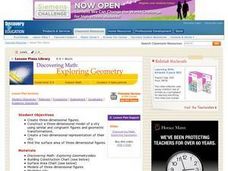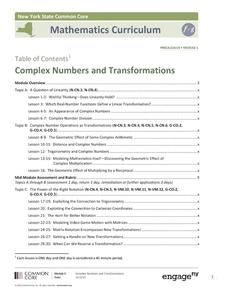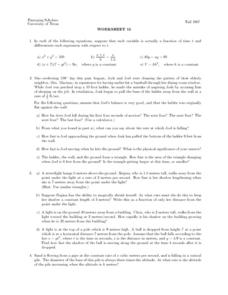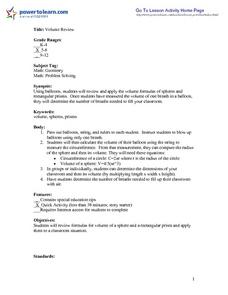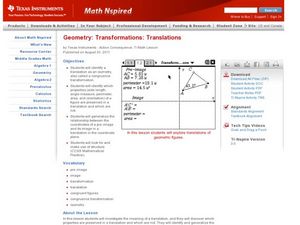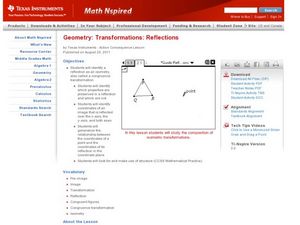Curated OER
Worksheet 5: Property Limits and the Squeeze Theorem
In this math worksheet, students answer 6 questions regarding given limits in a table of data, properties of limits and the Squeeze Theorem.
Curated OER
Multiplying Polynomials
Students explore the concept of multiplying polynomials. In this multiplying polynomials lesson plan, students watch a video clip about basic math skills. Students work in groups on an exploration about why a binomial squared equals a...
Curated OER
Naming Geometric Shapes
Name that shape! This simple activity has learners identify each geometric figure. They examine rectangular prisms, cylinders, rectangular pyramids, and hexagonal prisms. This one-page activity contains 8 problems, and the goals seems...
Discovery Education
Exploring Geometry
Middle schoolers construct a three-dimensional model of a city using both similar and congruent figures and geometric transformations. City must have at least ten buildings with each building labeled and may be constructed out of paper...
Curated OER
Math Handbook: Trigonometry
You'll be spinning in unit circles once you read through this jumbo-sized resource of everything you need to know about trigonometry. Each page has color-coded examples with explicit directions that detail the problems and formulas.
Curated OER
Matrix Madness!!
Perform operations to add, subtract, multiply and divide matrices. Then solve problems with vectors using matrices. A three day activity: Matrix Madness, Mystical Matrices, and Decode the Encode. The last activity has prizes that the...
EngageNY
Complex Numbers and Transformations
Your learners combine their knowledge of real and imaginary numbers and matrices in an activity containing thirty lessons, two assessments (mid-module and end module), and their corresponding rubrics. Centered on complex numbers and...
EngageNY
Modeling Riverbeds with Polynomials (part 2)
Examine the power of technology while modeling with polynomial functions. Using the website wolfram alpha, learners develop a polynomial function to model the shape of a riverbed. Ultimately, they determine the flow rate through the river.
NTTI
Vectors: Traveling, But in What Direction
High schoolers watch a video of real-world situations regarding speed, direction, velocity, force, etc. and answer questions while viewing. They then practice drawing and using vectors to solve more real-world problems.
Beauty and Joy of Computing
Building Your Own Blocks
Isn't building with blocks an activity for toddlers? The third lab of a five-part unit teaches young computer scientists how to create their own block instructions for programming. They use these blocks to create geometric figures, spell...
Curated OER
The Circle's Measure
Students explore circumference and diameter. For this math lesson, students apply their knowledge of circumference and diameter to solve mathematical riddles. Students apply this knowledge to find circumference and diameter of various...
Curated OER
Sine and Cosine
Learners solve problems using sine and cosine. In this precalculus lesson, students solve word problems using sine and cosine. They identify where it is appropriate to laws of sine and cosine and where to use the Pythagorean Theorem.
Curated OER
Vectors: How Much Force Can You Apply
This lesson entails the viewing of two videos to get an overview of force and its application. The lesson covers how vectors use force in real-world situations.
Curated OER
Which container holds a larger amount of popcorn?
What does popcorn have to do with math? Seventh grade mathematicians are provided an opportunity to develop a conceptual understanding of the formula for volume and to use it as a tool to solve problems. The lesson begins with a...
Curated OER
Worksheet 15 - Differentiation
In this differentiation worksheet, students determine the seconds of motion, identify the constant, and speed of movement. This two-page worksheet contains five multi-step problems.
Curated OER
Volume Review
Learners investigate the concepts of volume for rectangular prisms and spheres. They measure the volume of one balloon and then consider how many breaths it would take to fill the room with balloons. The rectangular prism being measured...
Curated OER
Shape Hunt
Explore the world of shapes! After free tangram exploration and pair share time, learners describe various patterns and shapes in both the natural and designed world. They investigate the use of tangrams to create patterns and shapes.
Curated OER
Rotations in the Plane
Pupils investigate the properties of a rotation as they use technology (Cabri, Jr.) to observe the relationship between the pre-image and the image formed by the rotation. The lesson provides ample opportunity for learners to conjecture...
Texas Instruments
The Leaning Tower of Pisa
Learners estimate the equation of a line, angle of elevation and depression in this math lesson. They analyze e famous landmark design and make connections to algebra and geometry. They will also generate an equation, model the x and y...
Curated OER
Octagon Lesson Plan
Students investigate octagons using words and shapes. In this geometry lesson, students discuss the shape of an octagon using physical and symbolic models. They make conjecture about the shape and relate it to the real world.
Curated OER
Transformations: Translations
High schoolers perform transformations and translations using polygons. In this geometry lesson, students perform transformations on a coordinate plane. They identify the image and pre-image of each figure.
Curated OER
Hunter Fred's Quest for Dinner
Learners solve problems using trigonometric functions, specifically a problem about a tree stand. Pupils try to maximize the distance of hunting sight given certain restrictions. They use the Pythagorean Theorem, sine, cosine, and...
Curated OER
Reference Angles
Learn how to measure the reference angles in degrees and radians. Young scholars find reference angles that are coterminal with a given angle.
Curated OER
Transformations: Reflections
Students perform transformations on their graphs. In this algebra instructional activity, students identify the pre-image and image. They find and identify congruent shapes and isometry.





